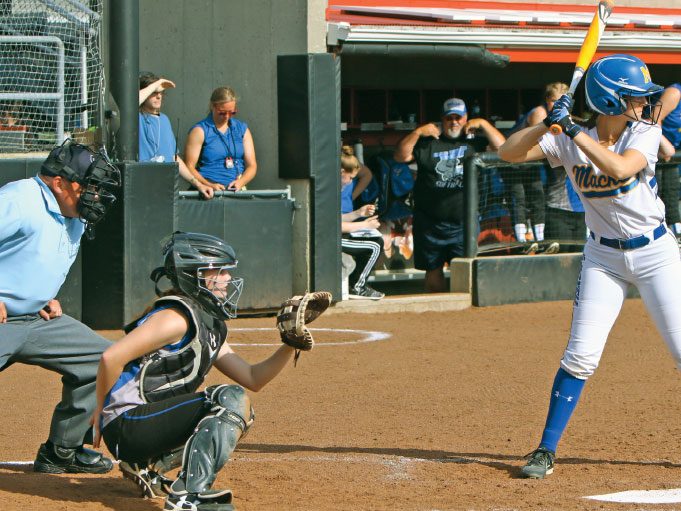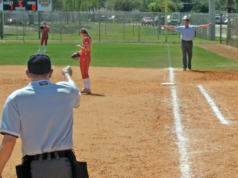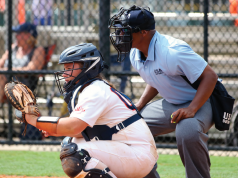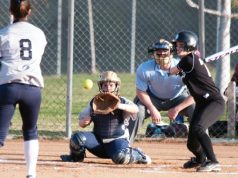The plate umpire in fast-pitch softball faces the demanding task of making split-second rulings hundreds of times each game, regardless of the competition level. Those who perform that responsibility best have one thing in common: consistency.
The concept of calling balls and strikes is straightforward. Each rules code defines the strike zone in specific language. In practice, however, things are more complicated. Pitches often change direction as they approach home plate, darting up or down, left or right.
Batters can be taller or shorter, and the size of the strike zone from top to bottom changes accordingly. Those batters may use an unorthodox stance, which forces the plate umpire to visualize the proper strike zone based on the “natural batting stance” specified in the rules codes of the NCAA, USA Softball, NFHS and the USSSA.
“The rulebook is our standard,” said Arthur “Butch” Andrey, the rules interpreter for the Chester County Chapter of Pennsylvania Interscholastic Athletic Association softball umpires. “But it’s still your judgment. If you want that perfect strike zone, better turn on that (video) machine.”
Achieving consistency while calling balls and strikes starts with the definition of the strike zone. In NFHS, USA and USSSA, it is the space over home plate between the batter’s armpit and the top of the knees when the batter assumes a natural batting stance. The NCAA specifies the bottom of the batter’s sternum instead of the armpit.
All rules codes specify that a pitch should be judged as it crosses home plate in flight, and a strike should be called on a pitch in which any part of the ball passes through the strike zone and the batter does not swing.
NCAA rules offer additional guidance to help umpires develop consistency in calling balls and strikes. The rulebook notes the width of the strike zone is fixed regardless of the batter. The plate itself is 17 inches wide and the diameter of a softball is 3.82 inches, making the actual width of the strike zone 24.64 inches when the inner edge of the ball is over the edge of the plate.
As a result, umpires should pay particular attention to the six-inch area between the edge of the plate and the inner edge of the batter’s box, often called “the river.” A pitch in that area should be ruled a strike only if any part of the ball passes over at least the edge of the plate.
Umpire Brandon Hibbler, Schnecksville, Pa., said developing a consistent strike zone is a key to ensuring a game proceeds smoothly. His approach is to be aggressive in calling strikes from the start of the game. He also pays close attention to whether a pitcher is focusing on the inside portion of the plate.
“I’m not going to give a pitcher (called strikes in) the river if she’s not hitting it consistently. That’s what she’s taught,” said Hibbler, who is in his seventh season as an NCAA umpire and has 10 years of NFHS experience, including a Pennsylvania state championship game. “You want to have a good flow to the game. If a pitcher throws strikes, you’re going to have a good flow. Having a consistent strike zone sets the tone. You’re really there for 14 innings (the seven innings for each team’s pitcher).
“You don’t want a coach frustrated about the strike zone early in the game. You always hear a coach complain because the strike zone is too tight, not too wide. You want to make the batter swing instead of making the pitcher work so hard.”
For Sonny Pompilii, of Chester, Pa., who began his umpiring career in 1970, consistency in calling balls and strikes starts with positioning. He stresses the importance of lining up in the slot position, which the various mechanics manuals describe as assuming a heel-toe stance behind the catcher, aligned slightly inside the inside corner of home plate and outside the perimeter of the strike zone.
He also suggests umpires be conscious of how far behind the catcher they line up. Pompilii recommends a distance of six to 10 inches. Too far back can cause umpires to not accurately judge the bottom of the strike zone and the outside corner of the plate.
From the slot, Pompilii advises umpires to focus on reaching the set position, the downward movement in which the umpire will lock the position of his or her head in order to judge the pitch. The key is to correctly time the movement to the set position as the pitcher prepares to throw.
“You’ve got to see the ball released. If you don’t see the release, the ball’s going to explode on you when it gets to the plate,” said Pompilii, who has officiated two International Softball Federation world championship tournaments and is the District 6 umpire-in-chief and a state deputy UIC for USA Softball of Pennsylvania. “A lot of new umpires go down as the pitcher is breaking her hands, getting ready to pitch, and they’re still going down as the catcher is catching the ball. I’d rather have them set up early, before the pitch is released, than late. You have to be still. Keep your head stationary, track the ball with your nose into the glove.”
When it comes to judging pitches, Pompilii said he focuses on positioning of the batter and the catcher in order to provide visual cues that help him achieve a consistent strike zone.
“Use the catcher as a tool, as far as her two shoulders and two knees, for the perimeter of the strike zone. If she catches it within that perimeter, nine times out of 10 it’s going to be a strike,” said Pompilii, a 30-year collegiate umpire who has worked five NCAA Division II national championship tournaments.
“If the catcher catches the ball with her glove up, it’s usually a strike. If she catches the ball with her glove down, it’s usually a ball.
“I look at the batter’s elbows,” he continued. “Just about all of them, the elbows are right at the sternum (when taking their stance). Have your eyes just below the top of the (strike) zone. That way you aren’t going to call a high strike. That’s the toughest pitch to hit in fast-pitch softball.”
While the ability to call a consistent strike zone involves a variety of factors and how each umpire implements them, most umpires agree on one concept: A pitch that is called a strike in the first inning must be called a strike in the last inning. Umpires should not change their interpretation of the strike zone as the game goes on.
“Whatever I call for one team, I’m going to call for the other team,” said Andrey, an East Fallowfield, Pa., resident who has more than 20 years of NFHS experience and 12 years as a collegiate umpire.
Andrey said his approach to achieving a consistent strike zone involves confidence, concentration and comfort.
“Confidence is No. 1; being prepared is the big thing, so I’m confident. … Understand situations of the game and the batter,” Andrey said. “Be comfortable. Make sure you see the pitch. You don’t want to hide behind the catcher. And you have to concentrate on every pitch. You can always make a mistake (if you lose concentration), and that mistake can get you in trouble.”
What's Your Call? Leave a Comment:
Note: This article is archival in nature. Rules, interpretations, mechanics, philosophies and other information may or may not be correct for the current year.
This article is the copyright of ©Referee Enterprises, Inc., and may not be republished in whole or in part online, in print or in any capacity without expressed written permission from Referee. The article is made available for educational use by individuals.



















